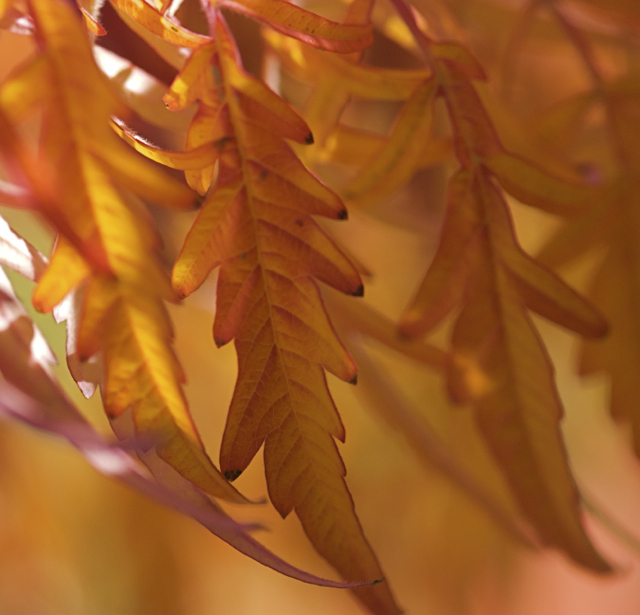
Cutleaf staghorn sumac (photo credit: Janice Tucker)
Scientific name: Rhus typhina ‘Laciniata’
Common name: Cutleaf staghorn sumac
Plant Family: Acardiaceae (Sumac)
Article and photos by Janice Tucker
The Cutleaf staghorn sumac is one hot looking plant in the fall. Its brilliant, red-orange, flame-shaped leaves are ablaze with color, even outshining other spectacular fall plants.
The Staghorn sumac (Rhus typhina) is native to eastern North America, Southeastern Canada and the Midwestern United States as well as in the Appalachian Mountains. It and its cultivars have adapted quite well to other regions. The Cutleaf staghorn sumac (Rhus typhina ‘Laciniata’) is one of the cultivars that thrives in Santa Fe.
The Cutleaf staghorn sumac is a deciduous shrub with a spreading growth habit. Shallow, lateral suckers can quickly establish stands of the plant. Its natural shape of a large shrub can grow up to 15 feet tall and 20 feet wide, but lower branches can be trimmed to raise the canopy to the shape of a small tree. Because of its lush, green, spring/summer foliage, a quick glance might give the impression that this is a type of tropical plant. Its lengthy branches are heavily lined with multitudes of long, odd-pinnately lobed, flame-shaped leaflets. Its common name, “staghorn”, refers to the velvety, curved branches and stems that resemble the new antlers of a male deer. In early summer, conical clusters of yellow flowers appear at the tip ends of branches. By mid-summer the flower cones have evolved into fuzzy, tightly packed, red berries. The berries are edible but very tart and most birds will eat them later, in the winter, when other food sources have diminished. The crowning glory of the Cutleaf staghorn sumac is its fall foliage. Fiery shades of red and orange will call attention to any location.

Cutleaf staghorn sumac leaves summer (photo credit: Janice Tucker)

Cutleaf staghorn sumac fall (photo credit: Janice Tucker)
Sun or partial sun is the best location for the Cutleaf staghorn sumac. It is not fussy about soil but planting in heavy clay should be avoided since this plant does not like its roots to stay wet for too long. It is adaptable to dry areas and works well in a xeric location. It also tolerates pollution and smog, making it a desirable plant in large cities. It can be used as an accent plant or blended with other plants in a woodland garden. For large gardens, the Cutleaf staghorn sumac is a good transitional choice when segueing from a more formal landscape to a natural one. It is resistant to diseases. Butterflies love it but harmful insects seem to leave it alone.

Cutleaf staghorn sumac fruit and branches (photo credit: Janice Tucker)

Cutleaf staghorn sumac late summer (photo credit: Janice Tucker)
Because the Cutleaf staghorn sumac spreads so easily, attention to maintenance is important, especially in areas where growth needs to be contained. Growth can be controlled by installing metal soil barriers to keep the suckers in check as well as by vigilant pruning. Some experts recommend cutting some or all of the stems down to the ground in late winter or early spring in order to keep it in check. It will come back in the spring. However, if this plant is to be used as a screen and its spread is not a problem, pruning may not be necessary.
Since planting from seed will not result in keeping the distinctive cut-leaf shape, it is best to propagate by digging up some of the suckers, making sure the roots are attached. After it has been established, water moderately. A note of interest is that some varieties of this cultivar’s leaflets may be thinner or of a finer texture.
The parent, Staghorn sumac, has some traditional and medicinal uses that will likely apply to its cultivars as well. Root bark has been used to staunch bleeding and Native Americans made a cough syrup or a gargle for sore throats from the fruit. Beekeepers use the wood from the sumac as fuel for their smokers. Steeping the berries in water, straining, and adding plenty of sugar makes a lemony-tasting drink. A natural dye can be made from the leaves, stems and fruit.
Light a fire of color in the fall garden by planting the Cutleaf staghorn sumac. Just the sight of it will keep you warm on those crispy, cool fall days.

Cutleaf staghorn sumac blazing leaves (photo credit: Janice Tucker)


